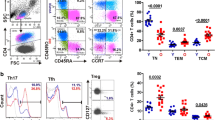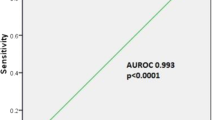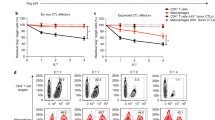Abstract
Progression to AIDS in asymptomatic HIV-infected individuals is characterized by a gradual but progressive loss of CD4+ T cells. While the mechanisms underlying this decline are currently unknown, recent evidence suggests that these cells are abnormally sensitive to apoptosis in response to activation signals. Recent work has implicated downregulation of Bcl-2 with the increased spontaneous apoptosis in lymphocytes from HIV-infected patients. We have evaluated the roles of the apoptosis-protective proteins Bcl-2 and Bcl-x in stimulated PBMC from asymptomatic HIV-infected and HIV-uninfected individuals. We found that Bcl-2 was constitutively expressed in PBMC from both HIV-infected and uninfected samples. However, Bcl-x induction was delayed and responses were decreased in stimulated HIV-infected samples. Additionally, single-cell intracellular staining of Bcl-x revealed a significant inverse correlation between PWM-induced Bcl-x expression and apoptosis (r = −0.695, P = 0.005). This was confirmed at the single-cell level in direct experiments when stimulated cells were sorted based on Bcl-x induction and then measured for apoptosis. Furthermore, low Bcl-x expression was not due to reduced lymphocyte activation following PWM stimulation. Our data indicate that the induction of Bcl-x is markedly impaired in asymptomatic HIV-infected patients and that stimuli which induce inadequate expression of Bcl-x are associated with increased levels of apoptosis in these cells.
Similar content being viewed by others
REFERENCES
Ho DD, Neumann AU, Perelson AS, Chen W, Leonard JM, Markowitz M: Rapid turnover of plasma virions and CD4 lymphocytes in HIV-1 infection. Nature 373:123-126, 1995
Wei X, Ghosh SK, Taylor ME, Johnson VA, Emini EA, Deutsch P, Lifson JD, Bonhoeffer S, Nowak MA, Hahn H, Shaw B: Viral dynamics in human immunodeficiency virus type 1 infection. Nature 373:117-122, 1995
Muro-Cacho C, Pantaleo G, Fauci AS: Analysis of apoptosis in lymph nodes of HIV-infected persons. Intensity of apoptosis correlates with the general state of activation of the lymphoid tissue and not with stage of disease or viral burden. J Immunol 154:5555-5566, 1995
Oyaizu N, McCloskey TW, Coronesi M, Chirmule N, Kalyanaraman VS, Pahwa S: Accelerated apoptosis in peripheral blood mononuclear cells (PBMCs) from human immunodeficiency virus type-1 infected patients and in CD4 cross-linked PBMCs from normal individuals. Blood 82:3392-3400, 1993
Ucker DS, Ashwell JD, Nickas G: Activation-driven T cell death. I. Requirements for de novo transcription and translation and association with genome fragmentation. J Immunol 143:3461-3469, 1989
Jaleco AC, Covas MJ, Victorino R: Analysis of lymphocyte cell death and apoptosis in HIV-2-infected patients. Clin Exp Immunol 98:185-189, 1994
Gougeon ML, Laurent CA, Hovanessian AG, Montagnier L: Direct and indirect mechanisms mediating apoptosis during HIV infection: Contribution to in vivo CD4 T cell depletion. Semin Immunol 5:187-194, 1993
Gougeon ML, Garcia S, Heeney J, Tschopp R, Lecoeur H, Guetard D, Rame V, Dauguet C, Montagnier L: Programmed cell death in AIDS-related HIV and SIV infections. AIDS Res Hum Retrovirus 9:553-563, 1993
Groux H, Torpier G, Monte D, Mouton Y, Capron A, Ameisen JC: Activation-induced death by apoptosis in CD4+ T cells from human immunodeficiency virus-infected asymptomatic individuals. J Exp Med 175:331-340, 1992
Finkel TH, Tudor WG, Banda NK, Cotton MF, Curiel T, Monks C, Baba TW, Ruprecht RM, Kupfer A: Apoptosis occurs predominantly in bystander cells and not in productively infected cells of HIV-and SIV-infected lymph nodes. Nat Med 1:129-134, 1995
Su L, Kaneshima H, Bonyhadi M, Salimi S, Kraft D, Rabin L, McCune JM: HIV-1-induced thymocyte depletion is associated with indirect cytopathogenicity and infection of progenitor cells in vivo. Immunity 2:25-36, 1995
Li CJ, Friedman DJ, Wang C, Metelev V, Pardee A: Induction of apoptosis in uninfected lymphocytes by HIV-1 Tat protein. Science 268:429-431, 1995
Westendorp MO, Frank R, Ochsenbauer C, Stricker K, Dhein J, Walczak H, Debatin KM, Krammer PH: Sensitization of T cells to CD95-mediated apoptosis by HIV-1 Tat and gp12O. Nature 375:497-500, 1995
Nardelli B, Gonzalez CJ, Schechter M, Valentine FT: CD4+ blood lymphocytes are rapidly killed in vitro by contact with autologous human immunodeficiency virus-infected cells. Proc Natl Acad Sci USA 92:7312-7316, 1995
Kroemer G, Petit P, Zamzami N, Vayssiere JL, Mignotte B: The biochemistry of programmed cell death. Faseb J 9:1277-1287, 1995
Cohen JJ: Apoptosis. Immunol Today 14:126-130, 1993
Wyllie AH, Kerr JFR, Currie AR: Cell death: The significance of apoptosis. Int Rev Cytol 68:251-306, 1980
Razvi ES, Welsh RM: Apoptosis in viral infections. Adv Virus Res 45:1-60, 1995
Dhein J, Walczak H, Baumler C, Debatin KM, Krammer PH: Autocrine T-cell suicide mediated by APO-1/(Fas/CD95). Nature 373:438-441, 1995
Brunner T, Mogil RJ, La FD, Yoo NJ, Mahboubi A, Echeverri F, Martin SJ, Force WR, Lynch DH, Ware CF, Green DR: Cell-autonomous Fas (CD95)/Fas-ligand interaction mediates activation-induced apoptosis in T-cell hybridomas. Nature 373:441-444, 1995
Ju ST, Panka DJ, Cui H, Ettinger R, El-Khatib M, Sherr DH, Stranger BZ, Marshak-Rothstein A: Fas (CD95)/FasL interactions required for programmed cell death after T-cell activation. Nature 373:444-448, 1995
Alderson MR, Tough TW, Davis-Smith T, Braddy S, Falk B, Shooley KA, Goodwin RG, Smith CA, Ramsdell F, Lynch DH: Fas ligand mediates activation-induced cell death in human T lymphocytes. J Exp Med 181:71-77, 1995
Itoh N, Tsujimoto Y, Nagata S: Effect of bcl-2 on Fas antigen-mediated cell death. J Immunol 151:621-627, 1993
Yonehara S, Ishii A, Yonehara M: A cell-killing monoclonal antibody (anti-Fas) to a cell surface antigen co-downregulated with the receptor of tumor necrosis factor. J Exp Med 169:1747-1756, 1989
Sato T, Irie S, Kitada S, Reed JC: FAP-1: A protein tyrosine phosphatase that associates with Fas. Science 268:411-415, 1995
Klas C, Debatin KM, Jonker RR, Krammer PH: Activation interferes with the APO-1 pathway in mature human T cells. Int Immunol 5:625-630, 1993
Katsikis PD, Wunderlich ES, Smith CA, Herzenberg LA, Herzenberg LA: Fas antigen stimulation induces marked apoptosis of T lymphocytes in human immunodeficiency virus-infected individuals. J Exp Med 181:2029-2036, 1995
Gehri R, Sinuhe H, Steuerwald M, Nuesch R, Erb P: The Fas receptor in HIV infection: Expression on peripheral blood lymphocytes and role in the depletion of T cells. AIDS 10:9-16, 1996
Iwai K, Miyawaki T, Takizawa T, Konno A, Ohta K, Yachie A, Seki H, Taniguchi N: Differential expression of bcl-2 and susceptibility to anti-fas-mediated cell death in peripheral blood lymphocytes, monocytes and neutrophils. Adv Virus Res 84:1202-1208, 1994
Yoshino T, Kondo E, Cao L, Takahashi K, Hayashi K, Nomura S, Akagi T: Inverse expression of bcl-2 protein and Fas antigen in lymphoblasts in peripheral lymph nodes and activated peripheral blood T and B lymphocytes. Blood 83:1856-1861, 1994
Fang W, Rivard JJ, Ganser JA, Le BT, Nath KA, Mueller DL, Behrens TW: Bcl-xL rescues WEHI 231 B lymphocytes from oxidant-mediated death following diverse apoptotic stimuli. J Immunol 155:66-75, 1995
Cuende E, Ales-Martinez JE, Ding L, Gonzalez-Garcia M, Martinez F, Nunez G: Programmed cell death by bcl-2-dependent and independent mechanisms in B lymphoma cells. EMBO J 12:1555-1560, 1993
Nunez G, London L, Hockenbery D, Alexander M, McKearn JP, Korsmeyer SJ: Deregulated Bcl-2 gene expression selectively prolongs survival of growth factor-deprived hemopoietic cell lines. J Immunol 144:3602-3610, 1990
Yin XM, Oltval ZN, Korsmeyer SJ: BH1 and BH2 domains of Bcl-2 are required for inhibition of apoptosis and heterodimerization with Bax. Nature 369:321-323, 1994
Veis DJ, Sorenson CM, Shutter JR, Korsmeyer SJ: Bcl-2-deficient mice demonstrate fulminant lymphoid apoptosis, polycystic kidneys, and hypopigmented hair. Cell 75:229-240, 1993
Boise LH, Gonzalez GM, Postema CE, Ding L, Lindsten T, Turka LA, Mao X, Nunez G, Thompson CB: bcl-x, a bcl-2-related gene that functions as a dominant regulator of apoptotic cell death. Cell 74:597-608, 1993
Korsmeyer SJ: Bcl-2 initiates a new category of oncogenes: Regulators of cell death. Blood 80:879-886, 1992
Motoyama N, Wang F, Roth KA, Sawa H, Nakayama K, Negishi I, Senju S, Zhang Q, Fujii S, Lo DH: Massive cell death of immature hematopoietic cells and neurons in Bcl-x-deficient mice. Science 267:1506-1510, 1995
Boise LH, Minn AJ, Noel PJ, June CH, Accavitti MA, Lindsten T, Thompson CB: CD28 costimulation can promote T cell survival by enhancing the expression of Bcl-XL. Immunity 3:87-98, 1995
Wang Z, Karras JG, Howard RG, Rothstein TL: Induction of bcl-x by CD40 engagement rescues sIg-induced apoptosis in murine B cells. J Immunol 155:3722-3725, 1995
Grillot DAG, Merino R, Nunez G: bcl-xL displays a restricted expression during thymic development and inhibits multiple forms of apoptosis but not clonal deletion. J Exp Med 182:1973-1983, 1995
Grillot DAG, Merino R, Pena JC, Fanslow WC, Finkelman FD, Thompson CB, Nunez G: bcl-x exhibits regulated expression during B cell development and activation and modulates lymphocyte survival in transgenic mice. J Exp Med 183:381-391, 1996
Boudet F, Lecoeur H, Gougeon M: Apoptosis associated with ex vivo down regulation of bcl-2 and up-regulation of fas in potential cytotoxic CD8+ T lymphocytes during HIV infection. J Immunol 156:2282-2293, 1996
Adachi Y, Oyaizu N, Than S, McCloskey T, Pahwa S: IL-2 rescues in vitro lymphocyte apoptosis in patients with HIV infection. J Immunol 157:4184-4193, 1996
Redfield RR, Wright DC, Tramont ET: The Walter Reed staging classification for HTLV-III/LAV infection. N Engl J Med 314: 131-132, 1986
Weng N-P, Levine B, June CH, Hodes RJ: Human naive and memory T lymphocytes differ in telomeric length and replicative potential. Proc Natl Acad Sci USA 92:11091-11094, 1995
Schimenti KJ, Jacobberger JW: Fixation of mammalian cells for flow cytometric evaluation of DNA content and nuclear immunofluorescence. Cytometry 13:48-59, 1992
McCloskey TW, Oyaizu N, Coronesi M, Pahwa S: Use of flow cytometric assay to quantitate apoptosis in human lymphocytes. Clin Immunol Immunopathol 71:14-18, 1994
Gottschalk AR, Boise LH, Thompson CB, Quintans J: Identification of immunosuppressant-induced apoptosis in a murine B-cell line and its prevention by bcl-x but not bcl-2. Proc Natl Acad Sci USA 91:7350-7354, 1994
Gorczcan W, Gong J, Darzynkiewicz Z: Detection of DNA strand breaks in individual apoptotic cells by the in situ terminal deoxy-nucleotidyl transferase and nick translational assay. Cancer Res 53:1945-1948, 1993
Levine BL, Mosca JD, Riley JL, Carroll RG, Vahey MT, Jagodzinski L, Wagner KF, Mayers DL, Burke DS, Weislow OS, St. Louis DC, June CH: Antiviral effect from CD28 costimulatory receptor mediates ex vivo CD4 T cell expansion from patients with HIV-1 infection. Science 272:1939-1942, 1996
Radvanyi LG, Shi Y, Vaziri H, Sharma A, Dhala R, Mills GB, Miller RG: CD28 costimulation inhibits TCR-induced apoptosis during a primary T cell response. J Immunol 156:1788-1798, 1996
Broome HE, Dargan CM, Krajewski S, Reed JC: Expression of Bcl-2, Bcl-x, and Bax after T cell activation and IL-2 withdrawal. J Immunol 155:2311-2317, 1995
Ohta K, Kazuyuki I, Kasahara Y, Taniguchi N, Krajewski S, Reed JC, Miyawaki T: Immunoblot analysis of cellular expression of Bcl-2 family proteins, Bcl-2, Bax, Bcl-x and Mcl-1 in human peripheral blood and lymphoid tissues. Int Immunol 7:1817-1825, 1995
Testi R, D'Ambrosio R, De Maria R, Santoni A: The CD69 receptor: A multipurpose cell-surface trigger for hematopoietic cells. Immunol Today 15:475-483, 1994
Noel PJ, Boise LH, Green JM, Thompson GB: CD28 costimulation prevents cell death during primary T cell activation. J Immunol 157:636-642, 1996
Abbas AK: Die and let live: eliminating dangerous lymphocytes. Cell 84:655-657, 1996
Kehry MR: CD40-mediated signaling in B cells balancing cell survival, growth and death. J Immunol 156:2345-2348, 1996
Akbar AN, Borthwick NJ, Wickremasinghe RG, Panayiotidis P, Pilling D, Bofill M, Krajewski S, Reed JC, Salmon M: Interleukin-2 receptor common γ-chain signaling cytokines regulate activated T cell apoptosis in response to growth factor withdrawal: Selective induction of anti-apoptotic (bcl-2, bcl-xL) but not proapoptotic (bax, bcl-xS) gene expression. Eur J Immunol 26:294-299, 1996
Sperling AI, Auger JA, Ehst BD, Rulifson IC, Thompson CB, Bluestone JA: CD28/B7 interactions deliver a unique signal to naive T cells that regulate cell survival but not early proliferation. J Immunol 157:3909-3917, 1996
Hickey T, Blair PJ, Perfetto S, Smoot D, Wagner K, St. Louise DC, Mayers D, Siegel JN, June CH: Intact antigen receptor-mediated calcium signals in patients with early stage HIV-1 infection. J Immunol 156:4012-4017, 1996
Author information
Authors and Affiliations
Rights and permissions
About this article
Cite this article
Blair, P.J., Boise, L.H., Perfetto, S.P. et al. Impaired Induction of the Apoptosis-Protective Protein Bcl-xL in Activated PBMC from Asymptomatic HIV-Infected Individuals. J Clin Immunol 17, 234–246 (1997). https://doi.org/10.1023/A:1027310612323
Issue Date:
DOI: https://doi.org/10.1023/A:1027310612323




